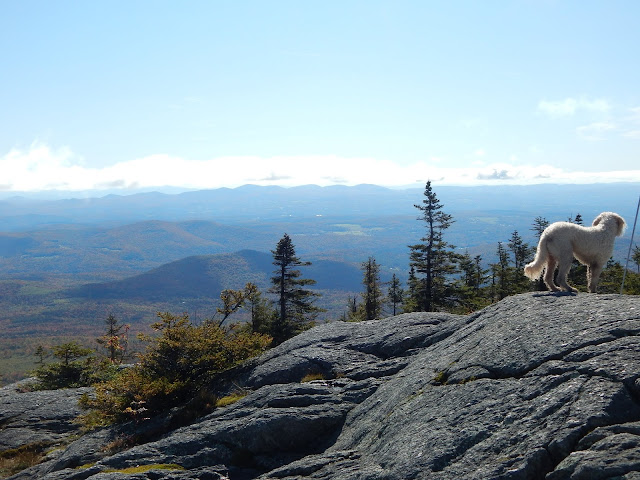On our ongoing quest for new sunrises from atop the mountains of the northeast, we saw it appropriate to return to the Adirondack High Peaks. We had already experienced a sunrise from a peak in the Adirondacks back in May, from Pharaoh Mountain. While we were going to leave it there, I thought it would be a good idea to return to the range, as the Adirondacks are a large range. I chose Hurricane Mountain (3,694') for it's open summit and fine views in all directions. This was definitely going to be a unique sunrise.
 |
| The fire tower atop Hurricane Mountain. |
Even though Hurricane Mountain is in the High Peaks region, it isn't a 4,000-footer, but it does provide one of the best views in the area. The most popular trail on the mountain climbs from Route 9N, but I chose to start the hike from the Crow Clearing trailhead to the north. My dad and I arrived at the trailhead early, where we eagerly started the hike. The first mile of the hike was smooth, following what was likely an old logging road.
 |
| The beginning of the trail. |
 |
| Perhaps an old logging road? |
Once at the junction with the Soda Range Trail, we continued on the Hurricane Mountain Trail, which crossed a small brook, then began at a steady grade. It brought us through an open forest, which was followed by a smooth trail over a brook. At this point, the path got rockier, and continued to climb through boreal forests. Soon it flattened out at the junction below the summit. Overall, an easy trail!
 |
| At the junction. |
 |
| Some rockier portions of the trail. |
After a bit of flat trail, we were brought to a steep rocky area, that when ascended, brings you to the first ledge on the summit. Upon our first time on the peak, there were no views, as the summit was completely socked in. Despite this, we still continued along the ledge all the way to the fire tower. We didn't spend too much time up there, as there was a very strong wind passing over the summit. We went back into the trees below the summit and set up camp, occasionally returning to the ledges.
 |
| The technical climb just before the ledges. |
 |
| Looking up toward the summit while in the clouds. |
 |
| The restored fire tower, and some remains of the former in the foreground. |
Upon our last climb to the summit that day, we waited for the sun to set. We knew we weren't going to see a great one, but it was worth watching. The skies had cleared up a lot, mostly to the north. To the north could be seen the Soda Range and Jay Mountain. Since the winds had eased up, I climbed the fire tower, which doesn't offer that much more to the view. Fire towers are a better gimmick then they are practical, but none the less, it's nice to have.
 |
| Through the clouds can be seen the Sentinel Range. |
 |
| Looking past the ledges toward Baxter Mountain. |
 |
| Jay Mountain and the Soda Range from Hurricane Mountain. |
 |
| From the fire tower, looking toward Lake Champlain. |
The western horizon turned orange beneath the clouds, and it was evident the sun would be setting soon. It wasn't the best sunset, but it was something. While there were still clouds around many of the high peaks, we trusted that the skies would clear up enough for the next morning in order to see the sunrise. We carefully made our way down the peak into the woods and off the trail back to our tent, where we awaited the sunrise.
 |
| Jay Mountain and the Soda Range before sunset. |
 |
| The sun shining through the clouds. |
 |
| Even though this is all we got, it's still beautiful. |
The sky began to brighten as we made our way back to the summit the next morning. We didn't have to wait long until the sun began to rise just over the Green Mountains and Lake Champlain, which both cleared up overnight. While clouds are usually a nuisance on hikes, they can occasionally add to the scenery, which is what I felt of them during the sunrise. There were just enough as not to block the sun, but make it more unique.
 |
| The sky before sunrise. |
 |
| The sun rising over Lake Champlain and Split Rock Mountain. |
 |
| A rough outline of the Green Mountains can be seen just below the sun. |
The skies were much wider now that the clouds eased up overnight. Some of the high peaks were visible, including Cascade and Porter, Giant Mountain, and Rocky Peak Ridge. Dix Mountain could be seen in the distance, with Nippletop Mountain nearby. The serrated ridge of Sawteeth Mountain was plainly visible. The Sentinel Range was in and out of the clouds all morning, and Whiteface Mountain never showed through.
 |
| The fire tower in silhouette. |
 |
| Giant Mtn, Macomb Mtn, Hough Mtn, Dix Mtn, Nippletop Mtn, Mt.Colvin, and Sawteeth |
 |
| The serrated ridge of Sawteeth Mountain. |
 |
| Mt.Whiteface and Esther Mountain from the ledges. |
We made our way down to camp and packed up, then continued our way back to the trailhead. Hurricane Mountain made for an excellent spot to see the sunrise. It was one of the best ones yet, with all the clouds and fall scenery adding to it. During our descent back to Crow Clearing, we noticed how quickly fall would be approaching. Seasons change much faster in the mountains, and it was evident, with the leaves turning yellow, and the autumn breeze beginning to roll in. I can't wait for fall!

















































